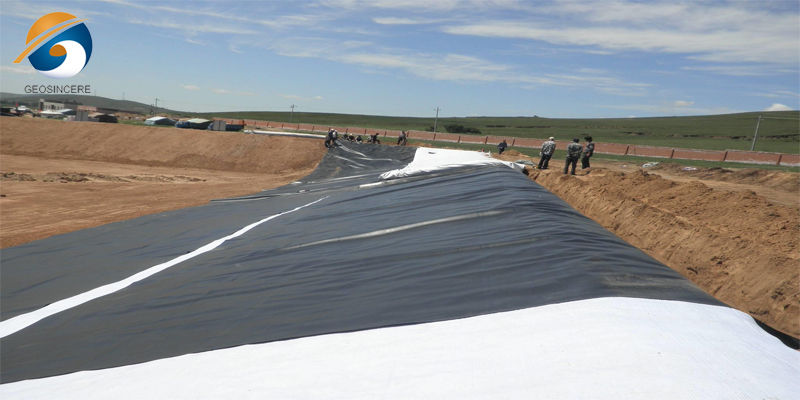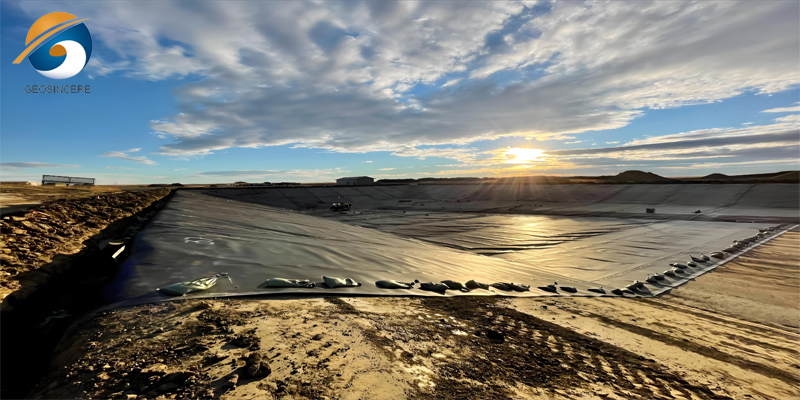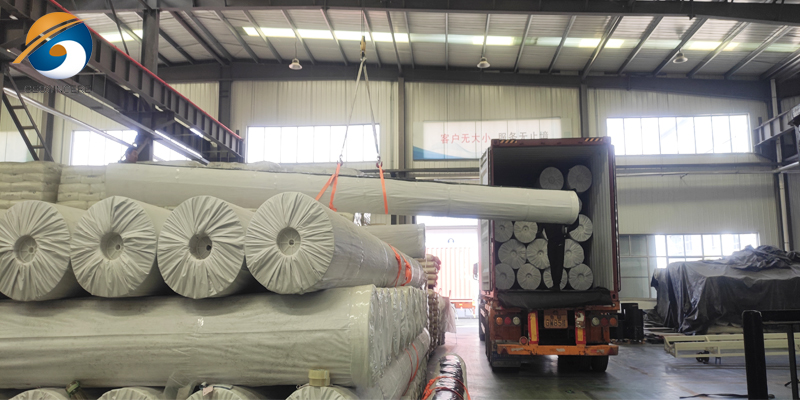Ultimate Guide To 60 mil HDPE Liner Price
60 mil HDPE Liner is a waterproof barrier material with high molecular polymer as the basic raw material. It has the characteristics of high strength, high corrosion resistance, high anti-aging, and anti-leakage, and is widely used in various construction projects.Many friends will be concerned about its price and what factors need to be considered when purchasing it. Let us explore it in this article.
1. Factors affected the 60 mil HDPE Liner price
The prices of 60 mil HDPE Liner are affected by a variety of factors, including material costs, production processes, market supply and demand, and brand and quality. These determining factors will be analyzed in detail below.
1.1 Material costs are the basic factors that determine the prices of 60 mil HDPE Liner . As the main raw material for geomembranes, the price fluctuations of HDPE (high-density polyethylene) directly affect the cost of geomembranes. The price of HDPE is affected by the price of oil, because oil is the main raw material for making HDPE. When the price of oil rises, the cost of 60 mil HDPE Liner will also increase, which in turn pushes up the price of geomembranes. In addition, transportation and storage costs are also part of the material cost. For markets far away from the production site or demand site, these costs may be higher, thus affecting the final price.
1.2 The production process also has a significant impact on the price of 60 mil HDPE Liner . Different production processes will lead to differences in production efficiency, product quality and waste disposal costs. Advanced production processes can improve production efficiency, reduce energy consumption and waste generation, thereby reducing production costs. At the same time, high-quality products tend to get higher market prices because they have more advantages in performance, durability and reliability.
1.3 Market supply and demand is another important factor that determines the price of 60 mil HDPE Liner. When market demand is greater than supply, prices tend to rise. Conversely, when supply is greater than demand, prices may fall. This supply and demand relationship is affected by a variety of factors, including the economic situation, infrastructure construction needs, policy orientation, etc. For example, during economic prosperity, the demand for infrastructure construction increases, and the demand for 60 mil HDPE Liner will also increase accordingly, pushing up prices.
1.4 Brand and quality are also important factors affecting the prices of 60 mil HDPE Liner . Well-known brands usually have a higher market share and credibility, so their products tend to get higher prices. At the same time, high-quality products usually have better performance and longer service life, so they can also get higher market prices. However, this does not mean that consumers have to buy the most expensive products, because products of different brands and qualities may have different applicability in different application scenarios.
2. Applications of 60 mil HDPE Liner
The application scope of 60 mil HDPE Liner anti-seepage is very wide, which can be classified according to the following aspects:
2.1 Anti-seepage of embankments, dams and gates
- Anti-seepage of earth-rock dam surface;
- Anti-seepage of earth-rock dam body;
- Anti-seepage of dam foundation cutoff wall;
- Covering upstream of dam and gate;
- Anti-seepage of cracks in concrete dam;
- Inflatable film dam;
- Pile ink cofferdam;
2.2 Anti-seepage of liquid storage reservoir
- Drinking water pool;
- Fish pond and shrimp pond;
- Salt field brine pool;
- Storage pool for various chemical solutions;
- Sewage pool and liquid waste storage pool;
- Oil storage pool;
- Anti-seepage of reservoir and tailings storage area;
2.3 Water, oil and liquid infusion channels
- Water channel;
- Sewage river;
- Oil transportation channels;
- Various waste channels for hydraulic transportation;
2.4 Anti-seepage of solid waste dumps
- Lining and anti-seepage of the rear wall and pit bottom of solid waste dumps;
- Capping of solid waste dumps to prevent the spread of toxic and odorous gases;
2.5 Others
- Roof anti-seepage;
- Moisture-proofing of building basements, underground tunnels, underground warehouses, and underground garages;
- Sealing of expansive soil to prevent water intrusion;
- Cutting off the source of frost heaving water with frost heaving soil;
High-Density Polyethylene (HDPE) liners are widely used in environmental containment, agriculture, landfill projects, and water management due to their excellent chemical resistance, durability, and impermeability. Among these, the 60 mil HDPE liner thickness is a popular choice balancing cost and performance. This comprehensive guide covers the factors affecting the price of 60 mil HDPE liners, technical specifications, relevant standards, installation considerations, and frequently asked questions, providing an authoritative resource for buyers and specifiers.
What is a 60 mil HDPE Liner?
A 60 mil HDPE liner is a geomembrane made from high-density polyethylene with a nominal thickness of 60 mils (1.52 mm). It serves as a flexible impermeable barrier in applications requiring containment of liquids or prevention of contamination.
Key Material and Performance Specifications
Thickness: 60 mils (approximately 1.52 mm)
Density: Typically ≥ 940 kg/m³
Tensile Strength: 25-30 MPa, per ASTM D6693
Elongation at Break: ≥ 700%, indicating excellent flexibility
Puncture Resistance: ≥ 250 N (ASTM D4833)
UV Resistance: Stabilized for outdoor exposure up to 10-15 years
Chemical Resistance: Resistant to acids, alkalis, solvents, and salts
Seam Strength: ≥ 18 MPa (ASTM D6392)
Factors Influencing 60 mil HDPE Liner Price
1. Raw Material Quality
Virgin HDPE resin vs. recycled blends
Additives such as carbon black for UV protection
Enhanced formulations for chemical or temperature resistance
2. Manufacturing Process
Extrusion vs. calendaring techniques affect cost and liner uniformity
Quality control certifications impact price
3. Liner Size and Roll Dimensions
Larger rolls reduce seam frequency and installation labor but may increase unit cost
Standard widths typically 7.5m to 8m, lengths vary
4. Compliance with Industry Standards
Meeting standards such as:
ASTM D5199 (Standard Test Method for Measuring Thickness)
ASTM D5887 (Standard Practice for Installation)
GSI GM17 (Geomembrane Specification)
Increases price due to testing and certification costs.
5. Installation and Accessory Costs
Seaming equipment and labor
Surface preparation and geotextile underlayments
Warranty and post-installation inspections
Typical 60 mil HDPE Liner Price Range
Raw Material Cost: $0.80 to $1.50 per square foot depending on quality and quantity
Installed Cost: Can range from $3.00 to $7.00 per square foot including labor and accessories
Prices fluctuate due to market resin costs, regional labor rates, and project complexity.
Engineering Principles & Application Examples
Impermeability: The 60 mil thickness provides an effective barrier with low permeability (<1 x 10^-13 cm/sec), suitable for preventing groundwater contamination.
Durability: High tensile strength and elongation allow withstanding soil movements and settlement without damage.
Flexibility: Enables conformance to complex geometries in ponds, landfills, or tanks.
Example: A municipal landfill requires a 60 mil HDPE liner installed over a compacted clay layer with a geotextile cushion. The liner must comply with EPA regulations to prevent leachate contamination.
Installation Best Practices and Regulatory Considerations
Surface Preparation: Smooth, debris-free base with minimal sharp objects to prevent punctures.
Seaming: Thermal fusion or extrusion welding techniques for strong, watertight joints.
Environmental Compliance: Installation must align with local and federal regulations (e.g., EPA Subtitle D for landfills).
Inspection and Testing: Non-destructive seam testing methods like vacuum box or air channel testing per ASTM D7002.







